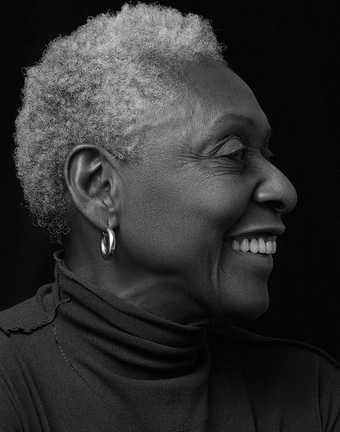
Bethann Hardison 2015
Hans Neumann
On her mission
I’ve worked in fashion for many years, both as a model and agent. I became an activist after I founded the Black Girls Coalition in 1987, and Iman joined in my plight to celebrate the black fashion model. Black models started to be featured in top editorials, adverts, catalogues and on the runway. It was worth celebrating. As time went by, the models of Black Girls Coalition grew up and slowly left the industry, leaving no replacements. The industry lost its sense of color and became whiter than white. My activism was called upon again to re-adjust what we were seeing. I’m not just fighting for the black model. That’s why I say models of colour, it covers a much broader spectrum — I care very much about anyone who is having difficulty because they are not Caucasian.
But really, I’m trying to help white people, because often it’s white people who think they’re very ‘liberal’, not realising that ‘liberal’ is a word that often times can be borderline racist. Ignorance can cause the results of racism. The people I’m trying to help are those who think there is nothing wrong.
On media representation

Emanuel Ungaro, Paris Fashion Week Spring/Summer 2016
Ambra Vernuccio
It comes down to how we see people nowadays; we see all kinds of people in everyday life, but how they’re represented in the media affects everybody. A perfect example is American Vogue. In the past, if Vogue used girls of colour they would, more than likely, have to be laughing, jumping or dancing. I was so taken aback when in January 2014 I went to get an issue of the magazine and it included three different portfolios of models of colour, which had never happened before.
It’s interesting, if people could just integrate the idea of how things would naturally look everyone could get used to it. Then it wouldn’t become such a big deal when you see a person of colour in a photo or a painting.
On colonialism
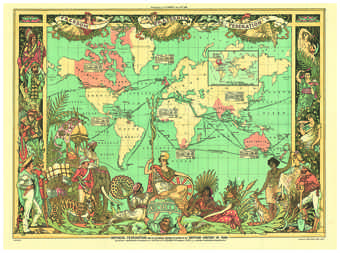
Walter Crane
Imperial Federation Map 1886
When people colonise an environment it’s never with the intent to incorporate; it’s always with the intent to have what is seemingly a good deal. They go in and push past the people. The people are gentle, the people are soft, the people are kind, the people are not aggressive, so it’s easy for the western men to get what they want. In this process culture can get lost. So the people who have been acquired have to try to stay true to the culture that they had.
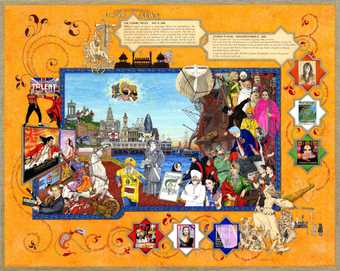
The Singh Twins
EnTWINed 2009
© Singh Twins (www.singhtwins.co.uk)
Commissioned by Museum of London
This image by The Singh Twins is a strong message because it reminds us that there were other people who helped create a culture. The dominant culture becomes something more than it was before it met the less dominant one, so you have a merged, diverse and strengthened culture.
That’s why it’s so important to educate people, to make them wake up and smell the coffee; because it’s everybody who makes something change, not just one group.
On cultural appropriation
I‘m not bothered if a white hairdresser decides to put the white models hair in cornrows for the Valentino collection. To me they’re referencing our culture. But the problem is they’re not telling anyone of the reference, which seems to bother many in the black community.
Well, gee whiz. What are they supposed to do? Come out over the loudspeaker or even write it into the little catalogue they put on the seats at fashion shows? So, people of colour, Native Indians, Latinos … basically everybody, has an angst about how their culture is not given credit.
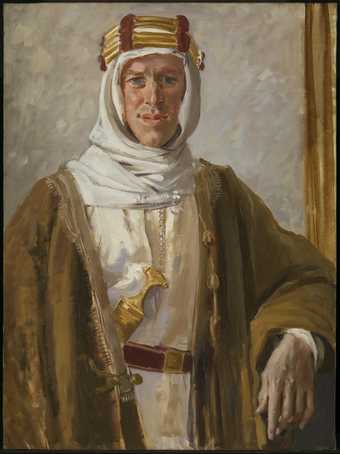
Augustus John OM
Colonel T.E. Lawrence
(1919)
Tate
© The estate of Augustus John. All Rights Reserved 2023 / Bridgeman Images
And to move on to the wonderful Colonel T.E. Lawrence portrait by Augustus John. Lawrence of Arabia was a good example of someone who really got involved in another culture. He knew the people, he knew the language, he lived there for many years. It makes a difference to have had that involvement in the culture. You understand the history and tradition of the clothes that you’re wearing, rather than just thinking ‘oh, I like the look of that’. It’s a subtle difference in context, and about respect.
On Victoria's Secret
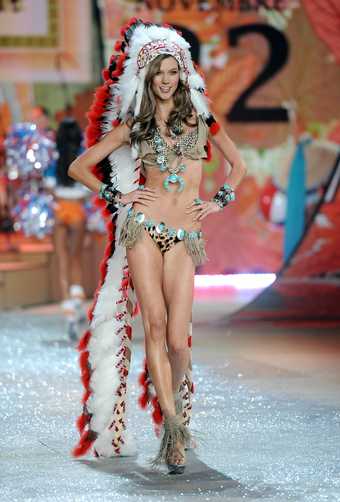
Karlie Kloss for Victoria's Secret 2012
Evan Agostini
There are things that can be understandably disturbing to a culture. For instance, the Victoria’s Secret show is very potent example of how the boundaries of respect can blur.
So when they mimic the Native American by walking with this beautiful headdress on, (which is quite beautiful by the way — I loved it on Karlie Kloss) it becomes offensive because the person whose culture is depicted knows that the person who is using it has no understanding of what it means. She couldn’t walk on to a reservation like that!
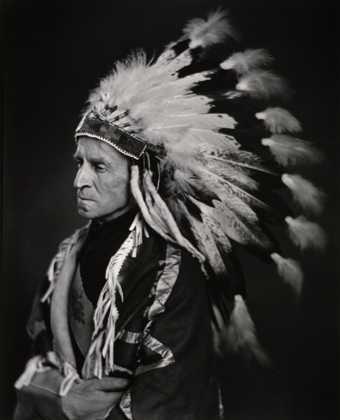
Yousuf Karsh
Sir John Buchan, 1st Baron Tweedsmuir, Governor General of Canada 1937
In my view, this image of Sir John Buchan, is not the same. You’d think he must really be part of it as the headdress was a gift from a Native Indian tribe. He may be a westerner but his experience has brought him closer to the culture, you can even tell by the way he put his head, and holds the coat that he respects the tradition.
On David Bowie
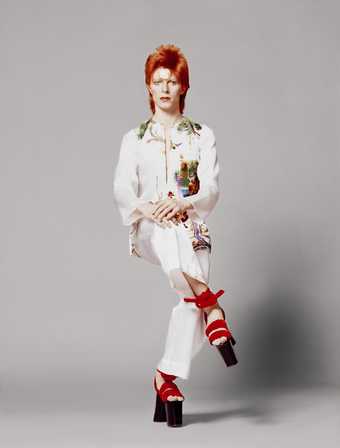
Masayoshi Sukita
David Bowie wearing Kansai Yamamoto New York, 1973.
© Photo by Sukita
When someone like David, who was such a visionary, references other cultures, it’s a whole other story. It was like he was not plucking off other cultures, he was looking to drown in it, because he was so inspired by it.
He was always going a little bit beyond the bar to stand up for things he believed in. If you left the little guy out he had no problem using his celebrity to question you on it. Once, at the beginning of MTV’s success, he questioned them on their lack of black musicians and talent in the music videos. He really kept MTV’s hand to the fire, and the interviewer started just tripping over his own feet. He was trying to make sense of it but it was just like he was walking deeper and deeper into a mess and he couldn’t explain why there were no black people present.
There are few people like that that come along in this world to push the button.
On painting
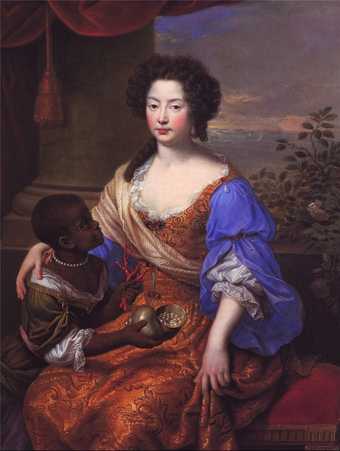
Pierre Mignard
Portrait of Louise Renee de Penancoet de Keroualle, Duchess of Portsmouth 1649-1734
The difficult thing about paintings is that sometimes they don’t really tell you enough. In Pierre Mignard’s portrait of the Dutchess Louise Rene de Kerouaille and the little Princess Louise Marie Therese, the black child is at the knee of a noble Victorian lady in a position of supplication.
If you look closer, though, the little girl has beads around her neck and she looks just as elegant as the Caucasian woman. So it’s unfair to determine what that story is because we don’t know without further research, and even then history is very biased. From what I did read, that little black child was prominent in some way, too. But who would know that?
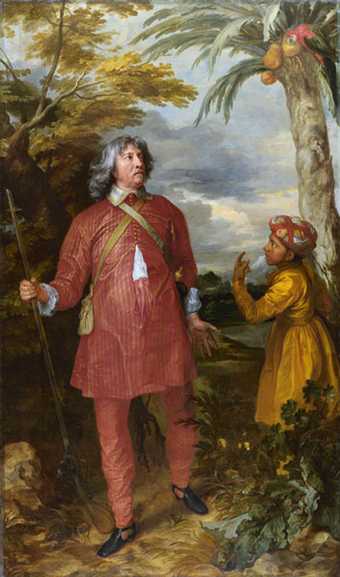
Anthony Van Dyck
William Fielding, 1st Earl of Denbigh c.1635–6
Oil on canvas
2475 x 1485 mm
The National Gallery, London. Presented by Count Antoine Seilern, 1945
But when you look at a painting like Sir Anthony Van Dyck’s portrait of William Feilding, 1st Earl of Denbigh it doesn’t make you feel respect for the gentleman because of his attitude of superiority. It doesn’t read like he could be learning something from this young person, rather he fits the convention of hierarchy, power and privilege.
History remains interesting …
